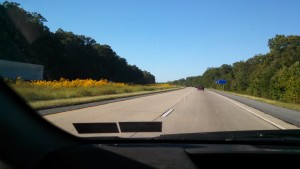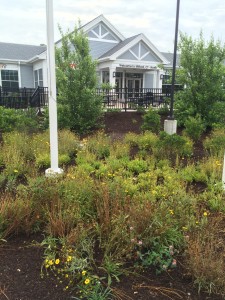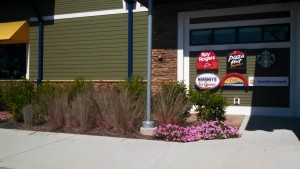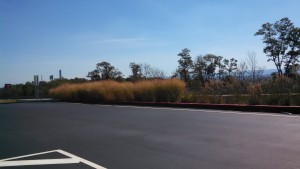It has taken a pretty long time but native plants are finally being accepted as beautiful landscape plants and flowers – they are still treated like specialty plants in many nurseries with their own little section away from the popular plants. But, as demand increases, that space will grow until it dissolves into the mainstream. Someday I will mention native plants and no one will raise an eyebrow.
and flowers – they are still treated like specialty plants in many nurseries with their own little section away from the popular plants. But, as demand increases, that space will grow until it dissolves into the mainstream. Someday I will mention native plants and no one will raise an eyebrow.
One group that has whole-heartedly adopted a native-frame-of-mind is state highway departments. Drive along Delaware  Route 1, and the Connecticut and Pennsylvania Turnpikes and what do you see? Long, narrow native plant gardens filled with grasses, wildflowers, bushes and trees that are tough, tenacious and truly American in spirit.
Route 1, and the Connecticut and Pennsylvania Turnpikes and what do you see? Long, narrow native plant gardens filled with grasses, wildflowers, bushes and trees that are tough, tenacious and truly American in spirit.
American, you say? Why is that? These plants are survivors. They grow in hot, blazing heat with only the water that nature provides by way of rain. They flower seasonally, fill in holes in the garden, survive even when getting run over by the errant car, and they beat back noxious weeds. That sort of sounds like the Pioneer settlers… and their ancestors… like Americans!
The Highway Departments started these gardens as a means to beautify and to reduce the mowing burden. Early adopters of this trend, states like North Carolina, tried huge plantings of annuals but they quickly changed the focus to perennial and self-seeding annual native plants to reduce maintenance costs.
and to reduce the mowing burden. Early adopters of this trend, states like North Carolina, tried huge plantings of annuals but they quickly changed the focus to perennial and self-seeding annual native plants to reduce maintenance costs.
The Highway Departments have done a lot of research and experimentation. I remember a lecture from years ago when Delaware was planning the new DE Route 1; one of the original criteria was that plants must be able to stop a 45 mph vehicle as it crossed the median strip during an accident. Where this requirement has been deemed necessary, simple barriers have been erected but for the most part, the highway is a garden. In the final DE highway manual, there are strict guidelines for plant location and type but they are more for consistency, sight-lines and general guidance and less for growing battering rams.
 It may seem odd to suggest that you take cues for your own garden from your local highway department…but why not? You would have a lot less work to do – they have already done the research about what grows best in your region, the plants they select are hardy and they are usually available in your garden center. Imagine swaths of white and yellow daisies, blue aster, goldenrod, blue fescue, and bayberry in your yard; Beautiful, seasonal, multi-seasonal color with watering requirements ranging from zero to minimal.
It may seem odd to suggest that you take cues for your own garden from your local highway department…but why not? You would have a lot less work to do – they have already done the research about what grows best in your region, the plants they select are hardy and they are usually available in your garden center. Imagine swaths of white and yellow daisies, blue aster, goldenrod, blue fescue, and bayberry in your yard; Beautiful, seasonal, multi-seasonal color with watering requirements ranging from zero to minimal.
Creating a beautiful landscape is a key element of sustainability – if it is beautiful you will nurture it and help heal the planet. Saving water is also a key sustainability goal. With the appropriate natives – the ones that the Highway Department has already identified AND planted – you can have your water and your scenery. So go out, take a drive, and take notes…maybe even stop for a bouquet…oh, wait, that might not be safe…better yet, go buy the plants. Soon you will be able to create that bouquet from your very own interstate inspired garden.
